Mathematics Education PhD Students Present at Research Symposium
Posted in: Faculty and Student Research, Mathematics Education PhD, Students and Alumni
On April 26, several members of the Mathematics Education Doctoral Program presented their research at the Student Research Symposium. The PhD program was represented by the following students: Helene Leonard, Amy Daniel, Youngjun Kim, Geena Taite, Elise Lahiere, Amanda Provost, Karmen Yu, Frank Forte, John O’Meara, and Ursula Derios. You can read more about these students’ presentations below, as well as peruse some pictures from the event. Congratulations to all of these scholars!
- Extraneous Solutions and Students’ Opportunities for Reasoning with Equations

Youngjun Kim
When solving radical or rational equations, students make reasonable decisions about what to use or choose (i.e., true solutions) and what not to (i.e., extraneous solutions). This study investigates mathematics textbook problems regarding extraneous solutions that are related to students’ reasoning competencies. This study examines the following research questions: (1) How do mathematics textbook problems regarding extraneous solutions provide opportunities to help students develop their skills in reasoning with equations? (2) What is the relationship between how textbook problems regarding extraneous solutions are worded and the opportunities for students’ development of skills in reasoning with equations?- The textbook problems are collected from high school mathematics textbooks, Big Ideas Math Algebra 1 and Algebra 2. By using Anderson and Krathwohl’s (2001) framework, sentences of the textbook problems regarding extraneous solutions are classified into different codes according to how the sentences are worded. In doing so, the framework helps understand what opportunities the textbook problems provide students to improve their reasoning skills. As a result, out of 228 sentences analyzed, the most frequent code is Applying Procedural Knowledge, which constitutes 47.81% of the total sentences. This indicates that the textbook problems disproportionately provide students with opportunities for reasoning with equations because one out of 24 codes accounts for almost half, and some codes only appear once or twice. The findings show that the textbook problems regarding extraneous solutions focus mainly on applying conceptual knowledge and that the textbooks provide insufficient opportunities to develop students’ skills in reasoning with equations.
- Exploring Changes in Mathematics Teacher Practice from Professional Development Rooted in the TRU Framework
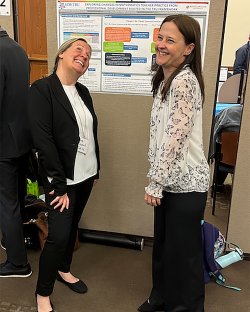
Helene Leonard and Amy Daniel
Powerful mathematics classrooms engage all learners with robust, coherent content in meaningful ways. The Teaching for Robust Understanding (TRU; Schoenfeld, 2015) framework outlines a vision of mathematical learning environments wherein all students can become independent mathematical thinkers. However, practicing teachers need support from professional development (PD) to learn to teach with this ambitious vision. Research has shown that, when being supported by effective PD, teachers can make positive changes in their instructional practice, develop teacher knowledge and productive beliefs, and better support student learning in their classrooms (Desimone, 2011).- This poster addresses the research question guiding our work: How does participation in PD centered on the collective investigation of video cases grounded in the TRU framework impact teachers’ use of high-quality instructional materials and practice? Informed by sociocultural theory, we employed an evaluative case study methodology to describe, explain, and assess the experiences of one middle school mathematics teacher’s longitudinal participation in a continuous PD model focused on the TRU framework. Data collected includes classroom observation videos from Year 1 and Year 4 and a semi-structured follow-up interview with the participant. Our findings show evidence of TRU-aligned changes in teaching practice as a result of years of participation in the PD model. These findings strengthen the call for PD programs focused on ambitious instructional strategies and suggest design elements of such PD to support effectiveness.
- Multiple Representations of Functions in a Calculus Open Educational Resource Compared to a Traditional Textbook
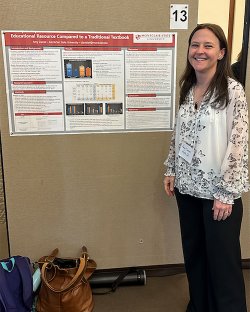
Amy Daniel
Open educational resources (OERs) are often lauded as vehicles of educational equity because their open-licensed, cost-free publication online makes them a viable alternative to overpriced college textbooks. However, agreed-upon measures of their quality compared to more traditional textbooks are lacking. This research investigates one possible such measure by comparing the emphasis two calculus textbooks place on the coordination of multiple representations (CMR) of functions, a process that has been linked to conceptual learning in mathematics. The research question guiding this work is: How does the prevalence and nature of student tasks requiring CMR of functions in the OER Active Calculus compare to that found in the traditionally-published Calculus, Early Transcendentals?- Between the two texts, 1,035 student tasks were analyzed and coded based on (1) whether or not they required CMR of functions, (2) which representations were to be coordinated (symbolic, graphic, numeric, or verbal), and (3) whether the task required construction of a new representation from a given one or perception of the relationship between two given representations. This analysis revealed that the OER was more likely than the traditional text to require students to make connections between multiple representations of functions. However, the traditional textbook was more likely to require the more cognitively demanding task of construction of a new representation. These results highlight the potential that OERs have to provide affordable access to mathematical resources of a quality comparable to (or perhaps even superior to) their traditionally-published counterparts.
- Characterizing Calculus I Students’ Participation In The Parallel Spaces Of Coursework And Inquiry-Oriented Supplemental Instruction
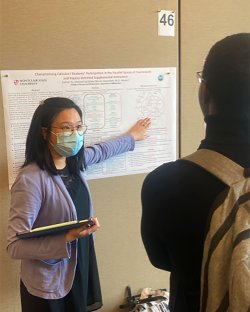
Karmen Yu
Calculus has long been known as a “gateway course” to STEM fields in postsecondary education. To address this issue, researchers in the Math Department at Montclair State University designed a model of supplemental instruction that features peer-facilitated workshops where Calculus I students work in groups on inquiry-oriented, groupworthy tasks. The purpose of this poster is to present preliminary findings of a multiple-case study that seeks to answer the question, “How do undergraduate Calculus I students experience and navigate their learning of calculus in the parallel spaces of coursework and inquiry-oriented supplemental instruction?” Preliminary findings presented in this poster will include characterizations of the different forms of agentive participation in each of the two spaces, contrasts between the two spaces, and their complementary nature relative to learning calculus with understanding. As this study progresses, the findings presented here will be used to address this research question more deeply.- Supporting Pre-Service Teachers as They Begin Their Mathematical Modeling Journey
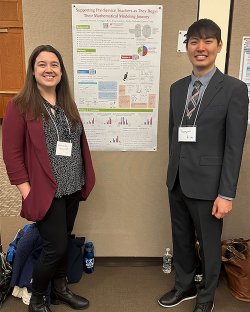
Amanda Provost and Youngjun Kim
A mathematical model “is a representation of a system or scenario that is used to gain qualitative and/or quantitative understanding of some real-world problems and to predict future behavior” (Bliss et al., 2014, p. 3). CCSSM and NJSLSM call for students to be able to engage in the mathematical practice of modeling; however, modeling is not always a main focus in teacher education curricula. To learn how to best support pre-service teachers (PSTs) as they begin to engage with mathematical modeling, we conducted two 75-minute sessions with PSTs where we: provided an introduction, had participants engage in two modeling tasks, and provided additional resources.- From these sessions we utilized pre- and post-surveys along with audio recordings of the PSTs working in groups. This poster reports on the design and implementation of these two sessions, the benefits and concerns the PSTs noted while engaging in the sessions, and suggestions for the design of future sessions with PSTs. We found that PSTs had little prior exposure to mathematical modeling, yet were interested in and benefited from engaging collaboratively in the modeling enactments. The PSTs reported concerns about enacting modeling in their future classrooms, which included managing time constraints, supporting students’ mathematical thinking, and overcoming student frustration. Our recommendations for the design of future modeling sessions with PSTs include providing them with more examples of modeling tasks, having them watch implementation of modeling tasks by a practicing teacher with students, and having PSTs find and evaluate modeling tasks.
- Tracing the Mathematical Modeling Phases of Pre-Service Teachers: A MAD Analysis

Elise Lahiere and Geena Taite
Mathematical modeling has been receiving increased focus with researchers identifying its benefits for students, such as using mathematics in real world applications and affecting change in attitudes towards mathematics. Mathematical modeling also provides the opportunity to support equitable learning, promoting cooperation among students from various mathematical backgrounds with the use of low-floor and high-ceiling tasks.- With numerous benefits, it is important to also examine how groups of pre-service teachers negotiate the modeling process in order to better support those who look to include modeling activities in their future classroom. While there have been several theoretical modeling cycles published that describe the various phases, these tend to provide a simplified view of the complex nature of these tasks. To gain insight into this phenomena, we created, taught, and observed two mathematical modeling sessions for pre-service teachers. This work enabled us to explore how pre-service teachers move between phases of the modeling cycle and if these shifts mirror what is being represented in current modeling cycle diagrams.
- Our analysis focuses on a holistic task that was completed after pre-service teachers had learned about mathematical modeling and had attempted an atomistic task. We used a modified version of the Modeling Activity Diagram (MAD) framework to create a visual representation of group movements through the modeling cycle phases. While our analysis is ongoing, our emerging findings show that pre-service teachers are able to adapt to the complex nature of modeling activities to varying degrees as they work together to build their mathematical models.
- Designing & Implementing Professional Development on Mathematical Modeling to Address Evolving Teacher Challenges
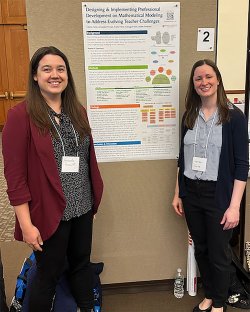
Amanda Provost and Geena Taite
Mathematical modeling is one of the Common Core State Standards for Mathematical Practice (MP 4) that can be used as a vehicle for learning mathematical content standards. However, there are many challenges faced by both teachers implementing mathematical modeling and students engaging with mathematical modeling tasks. While many of these challenges are already known, it is less clear how teacher challenges implementing mathematical modeling evolve over time. In this action research study, a team of five doctoral students (including a teacher-researcher) responsively designed professional development (PD) on mathematical modeling during the 2021-2022 school year for high school Algebra 1 and 2 teachers implementing mathematical modeling for the first time. In this study, we report on how teacher challenges evolved over time and how we as researchers addressed those challenges through professional development.- Data was collected through surveys, interviews, PD sessions, check-ins, and observations. The constant comparative method was used to analyze the data as it was collected to inform the design of the PD sessions. Scaffolding, student engagement, and student modeling mindset were mostly early challenges. Teachers indicated student engagement as an early challenge, but towards the end of the year frequently indicated that it was a positive of modeling. By mid-year (January), fewer challenges related to students’ modeling mindset were reported. Both the nature and duration of teacher challenges related to mathematical modeling have implications for how to support school districts and their teachers as they engage in mathematical modeling with their students.
- Mapping Their Terrain: Using Social Network Theory to Promote Teacher Leadership Development
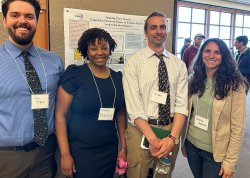
John O’Meara, Ursula Derios, Timothy Aberle, and Shanna Anderson In this poster, we present research on teacher leadership networks and a network mapping tool we developed to analyze the social networks of science teacher leaders from the Wipro Fellowship program and assess their use of human capital. To frame this study, we used social network theory to analyze educational change through the connected network of actors (Daly, 2010). Our primary research question is How can the construction of social network maps (SNM) and project-oriented professional development be leveraged to support teacher leadership identity?Social network theory promotes the use of mapping to deepen the understanding of one’s perceived group connections. However, there is no standard process to create such maps. Further, SNM are often created by researchers through an interview process rather than by participants themselves. We address these gaps by developing a tool to create SNM as it relates to each fellow’s district-based leadership initiative. We facilitated the development of SNM to enable teacher leaders to analyze their available human capital. Through an initial coding of the participant SNM and follow-up interviews, we found that, while the SNM tool provides the space to illuminate stakeholders, Wipro Fellow participants were unclear about how this tool could be used to analyze their use of human capital as a means to impact their project. This finding suggests the need for targeted professional development that would support teachers to use this tool to plan and implement their teacher leadership initiatives.
